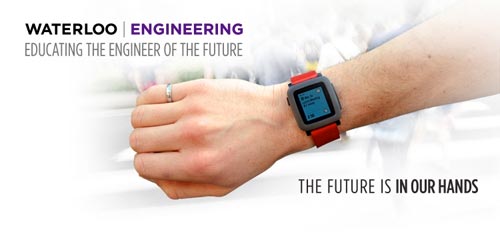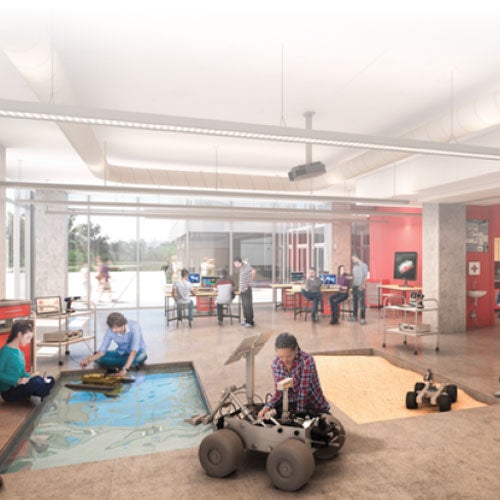
Waterloo launches campaign to educate the engineer of the future
The Engineering Ideas Clinic™ and an indoor flight testing centre are just part of the Educating the Engineer of the Future campaign

The Engineering Ideas Clinic™ and an indoor flight testing centre are just part of the Educating the Engineer of the Future campaign
By Carol Truemner Faculty of EngineeringStudent experience will literally reach new heights in Robozone, part of the vision of the $70 million Educating the Engineer of the Future campaign launched by the Faculty of Engineering.

The two-storey indoor flight centre for testing autonomous and robotic vehicles is one of the innovative features of Engineering 7 (E7), the 230,000-square-foot, seven-storey building to be funded by the campaign.
To accommodate major undergraduate growth, E7 will provide much-needed teaching space for the Faculty’s new biomedical engineering, which received over 900 applications this year, and expanded mechatronics engineering programs. It will house some of the best research facilities in the world, including an additive manufacturing (3D printing) laboratory. E7 will also be home to the Conrad Business, Entrepreneurship and Technology Centre and the multidisciplinary Engineering Ideas Clinic™, where undergraduate students integrate classroom theory with hands-on learning as they design, build, test and refine ideas. Construction on E7 is expected to begin this fall and take three years.
 Other campaign goals are to establish research chairs in emerging technologies and increase undergraduate and graduate scholarships to attract the best and brightest students to the Faculty.
Other campaign goals are to establish research chairs in emerging technologies and increase undergraduate and graduate scholarships to attract the best and brightest students to the Faculty.
The Educating the Engineer of the Future vision is based on giving engineering students enhanced experiences to help them achieve their aspirations and ensure they are uniquely prepared for the future, explains Pearl Sullivan, Dean of Engineering.
“We will use the $70 million raised to expand educational opportunities, open up new avenues of research, create innovation that helps drive the economic engine of Canada and helps shape the future of technology,” says Sullivan. “With our world-leading research institutes and centres – many deeply involved in emerging and disruptive technologies – Waterloo Engineers are having a profound impact on the future of technology around the world.”
The campaign’s website features stories about Waterloo Engineering’s students, graduates, researchers and faculty members along with remarkable innovations like the Waterloo Pump, which put the University, as well as the City of Waterloo, on the map. It also includes the campaign video produced by Angle Media Group, co-founded by Master of Business, Entrepreneurship and Technology graduates.
“The campaign is an important undertaking for everyone in our Faculty,” says Sullivan. “Nearly 60 years ago, we redefined engineering education with co-op. We need to build upon that bold vision and continue to lead in Educating the Engineer of the Future.”

Read more
New building will house research on machine intelligence, mobile robotics, autonomous vehicles and wearable biomedical devices

Read more
Special issue of Waterloo Magazine celebrates women who lead, and explores equity in education and the workplace

Read more
The innovative facility will inspire entrepreneurs and support the next wave of high-impact research
Read
Engineering stories
Visit
Waterloo Engineering home
Contact
Waterloo Engineering
The University of Waterloo acknowledges that much of our work takes place on the traditional territory of the Neutral, Anishinaabeg, and Haudenosaunee peoples. Our main campus is situated on the Haldimand Tract, the land granted to the Six Nations that includes six miles on each side of the Grand River. Our active work toward reconciliation takes place across our campuses through research, learning, teaching, and community building, and is co-ordinated within the Office of Indigenous Relations.